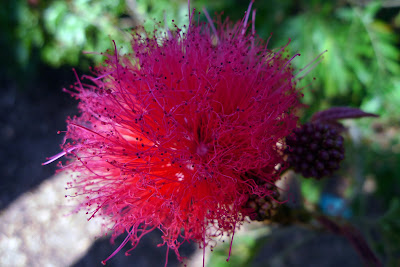Earlier this week I got back a new batch of thin sections from Burnham Petrographics. Since almost all the detrital zircons in my metasediment thick (200 micron) sections were destroyed after laser ablation for U-Pb and Hf isotopes, I got several new sections made. This time, though, I decided to go for the 1-inch circular section (in the event I do anything cool with zircons on the SIMS in the future). Also, I made them 30 microns thick, just to see whether I could decipher any new textural information. It's difficult for me to see all the textures in 200 micron thick sections, particularly when there are ambiguous phases present like in these metasediments. One such phase is a dark decrepitated brownish-black phase that is some kind of feldspar, but also a mixture with some mafic components (it may be some garnet breakdown product or perhaps a reaction with fspar and something else to form garnet). Anyway, in the thick sections, this phase just looks like a clots of dark brown, amorphous
stuff. In the thin sections, though, several revealing new features have come to light:

In the center of this photograph, you can clearly see a relict plagioclase twinning. Such relict twinning is commonly seen in many of the clots of dark stuff, thanks to the thinner section. In the photo below, that's the same dark stuff with the microscope light turned up to the maximum intensity. You can't make any relict textures out.

I took this photo not for the dark stuff but for the beautiful little trio of detrital minerals - graphite (? topmost left, fuzzy within the quartz lattice plane), rutile (amber-colored), zircon (tiny bright speck with high relief), and monazite (? I think; the pale green equant grain with comparatively lower relief).

Take a look at this spectacular texture in the above photo. The large grain is garnet, with several inclusions. The grey mineral is quartz, notice the undulatory extinction. The bright silvery patches are the abovementioned dark stuff (some sort of contaminated ternary feldspar mixture). Upon closer inspection, if you zoom in to high mag... you can actually see individual feldspar laths within this phase, further confirming that it's feldspar. It almost looked like the plag-rich groundmass in volcanic rocks, which got me wondering... could that "vein" splitting the garnet down the middle in the photo be some alkali-rich melt infiltration (possibly the host lava?). There are definitely some oxidized phases, probably associated with late stage events, rimming the garnet (the rusty orange phases). Texturally (and also shown by micro-XRF maps not shown here), there is evidence for melt infiltration. However, I still think most of the "dark stuff" (here, "bright stuff"), is probably original feldspar that broke down. I'm still contemplating a lot of the textures I observed today, so more thoughts later. For now, I leave you with one last fun photo. Below is a binary system of detrital zircons in quartz (for some reason the quartz looks greenish; it's possibly my camera). The bigger zircon fractured the quartz around it. Look at how round these zircons are! They are most certainly detrital in origin...





















